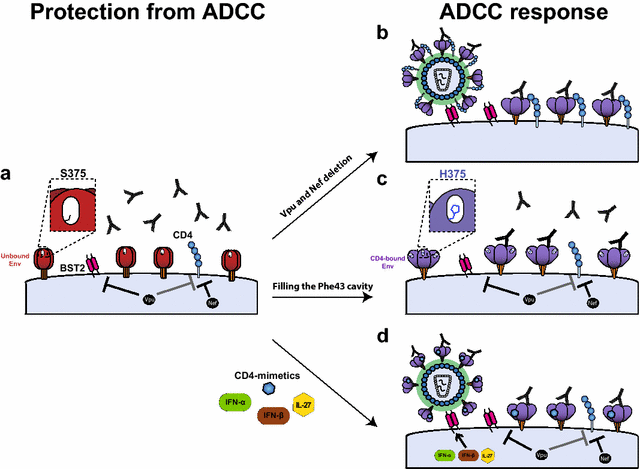Unlocking HIV-1 Env: implications for antibody attack
- PMID: 28893275
- PMCID: PMC5594528
- DOI: 10.1186/s12981-017-0168-5
Unlocking HIV-1 Env: implications for antibody attack
Abstract
Collective evidence supporting a role of Antibody-Dependent Cell-Mediated Cytotoxicity (ADCC) in controlling HIV-1 transmission and disease progression emerged in the last few years. Non-neutralizing antibodies (nnAbs) recognizing conserved CD4-induced epitopes on Env and able to mediate potent ADCC against HIV-1-infected cells exposing Env in its CD4-bound conformation have been shown to be present in some RV144 vaccinees and most HIV-1-infected individuals. HIV-1 evolved sophisticated strategies to decrease exposure of this Env conformation by downregulating CD4 and by limiting the overall amount of cell-surface Env. In this review, we will summarize our contribution to this rapidly evolving field, discuss how structural properties of HIV-1 Env might have contributed to the modest efficacy of the RV144 trial and how we recently used this knowledge to develop new strategies aimed at sensitizing HIV-1-infected cells to ADCC mediated by easy to elicit nnAbs.
Keywords: ADCC; BST-2; CD4; CD4-mimetics; Env; HIV-1; Nef; RV144; Vpu; gp120.
Figures

Similar articles
-
Interaction with cellular CD4 exposes HIV-1 envelope epitopes targeted by antibody-dependent cell-mediated cytotoxicity.J Virol. 2014 Mar;88(5):2633-44. doi: 10.1128/JVI.03230-13. Epub 2013 Dec 18. J Virol. 2014. PMID: 24352444 Free PMC article.
-
BST-2 Expression Modulates Small CD4-Mimetic Sensitization of HIV-1-Infected Cells to Antibody-Dependent Cellular Cytotoxicity.J Virol. 2017 May 12;91(11):e00219-17. doi: 10.1128/JVI.00219-17. Print 2017 Jun 1. J Virol. 2017. PMID: 28331088 Free PMC article.
-
Incomplete Downregulation of CD4 Expression Affects HIV-1 Env Conformation and Antibody-Dependent Cellular Cytotoxicity Responses.J Virol. 2018 Jun 13;92(13):e00484-18. doi: 10.1128/JVI.00484-18. Print 2018 Jul 1. J Virol. 2018. PMID: 29669829 Free PMC article.
-
Impact of HIV-1 Envelope Conformation on ADCC Responses.Trends Microbiol. 2018 Apr;26(4):253-265. doi: 10.1016/j.tim.2017.10.007. Epub 2017 Nov 20. Trends Microbiol. 2018. PMID: 29162391 Review.
-
Conformation-Dependent Interactions Between HIV-1 Envelope Glycoproteins and Broadly Neutralizing Antibodies.AIDS Res Hum Retroviruses. 2018 Sep;34(9):794-803. doi: 10.1089/AID.2018.0102. Epub 2018 Jul 17. AIDS Res Hum Retroviruses. 2018. PMID: 29905080 Review.
Cited by
-
Evolution of Antibodies to Native Trimeric Envelope and Their Fc-Dependent Functions in Untreated and Treated Primary HIV Infection.J Virol. 2021 Nov 23;95(24):e0162521. doi: 10.1128/JVI.01625-21. Epub 2021 Sep 29. J Virol. 2021. PMID: 34586863 Free PMC article.
-
Flow Cytometry Analysis of HIV-1 Env Conformations at the Surface of Infected Cells and Virions: Role of Nef, CD4, and SERINC5.J Virol. 2020 Feb 28;94(6):e01783-19. doi: 10.1128/JVI.01783-19. Print 2020 Feb 28. J Virol. 2020. PMID: 31852789 Free PMC article.
-
The Genesis and Future Prospects of Small Molecule HIV-1 Attachment Inhibitors.Adv Exp Med Biol. 2022;1366:45-64. doi: 10.1007/978-981-16-8702-0_4. Adv Exp Med Biol. 2022. PMID: 35412134 Review.
-
Temsavir blocks the immunomodulatory activities of HIV-1 soluble gp120.Cell Chem Biol. 2023 May 18;30(5):540-552.e6. doi: 10.1016/j.chembiol.2023.03.003. Epub 2023 Mar 22. Cell Chem Biol. 2023. PMID: 36958337 Free PMC article.
-
Characterization of Human Immunodeficiency Virus (HIV-1) Envelope Glycoprotein Variants Selected for Resistance to a CD4-Mimetic Compound.J Virol. 2022 Sep 14;96(17):e0063622. doi: 10.1128/jvi.00636-22. Epub 2022 Aug 18. J Virol. 2022. PMID: 35980207 Free PMC article.
References
-
- Bonsignori M, Pollara J, Moody MA, Alpert MD, Chen X, Hwang KK, Gilbert PB, Huang Y, Gurley TC, Kozink DM, et al. Antibody-dependent cellular cytotoxicity-mediating antibodies from an HIV-1 vaccine efficacy trial target multiple epitopes and preferentially use the VH1 gene family. J Virol. 2012;86(21):11521–11532. doi: 10.1128/JVI.01023-12. - DOI - PMC - PubMed
-
- Veillette M, Desormeaux A, Medjahed H, Gharsallah NE, Coutu M, Baalwa J, Guan Y, Lewis G, Ferrari G, Hahn BH, et al. Interaction with cellular CD4 exposes HIV-1 envelope epitopes targeted by antibody-dependent cell-mediated cytotoxicity. J Virol. 2014;88(5):2633–2644. doi: 10.1128/JVI.03230-13. - DOI - PMC - PubMed
Publication types
MeSH terms
Substances
LinkOut - more resources
Full Text Sources
Other Literature Sources
Medical
Research Materials

